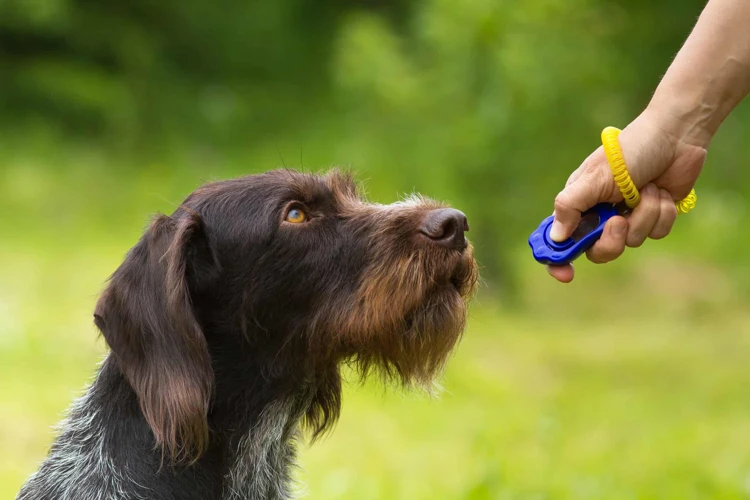As a pet parent, leash training your American Wirehair can be a daunting task. It can be frustrating when your furry friend pulls on the leash or has difficulty following your lead. However, with the right training techniques and tools, you can make leash training a breeze for both you and your beloved pet. One effective technique that you can try is clicker training. In this comprehensive guide, we will explore the benefits of clicker training for leash training your American Wirehair and provide you with valuable step-by-step instructions to help you get started. With perseverance and patience, you can build a strong bond with your pet and empower them to become a well-trained and obedient companion.
What is Clicker Training?

Are you struggling to train your American Wirehair to walk on a leash without pulling and tugging at the leash? Have you heard of the benefits of clicker training but aren’t sure where to start? Clicker training is a popular and effective method for teaching dogs new behaviors and reinforcing good behavior. In this section, we’ll explore what clicker training is and how it can be used for leash training your American Wirehair. By using this positive reinforcement training technique, you can build trust and communication with your furry friend, which can make your future leash training sessions more successful. So, let’s dive in and explore the world of clicker training for your American Wirehair! Don’t forget to check out our guide to leash training your American Wirehair for more information.
How Does Clicker Training Work?
One of the key principles behind clicker training is operant conditioning. Operant conditioning is the process of learning through consequences. In the case of clicker training, the click of the device serves as a consequence for a specific behavior. Essentially, you are training your dog to associate the sound of the click with a desired behavior. This is done by using the clicker to mark the behavior every time it is exhibited, followed immediately by a reward like a treat or positive reinforcement like praise.
To understand how clicker training works, let’s look at a simple example. Imagine you are trying to teach your American Wirehair to sit on command. You would begin by waiting for your dog to naturally sit. The moment your dog’s rear end touches the ground, you would click the clicker and immediately give a treat. Repeat this process multiple times, eventually introducing the command word “sit” as you click and treat. Over time, your Wirehair will learn to associate the word “sit” with the click and treat, and will begin to sit on command.
The clicker helps to very precisely identify the moment that your dog exhibits the desired behavior. This precision is important because it allows your dog to quickly learn which behaviors are being rewarded. Additionally, clicker training allows you to shape complex behaviors by breaking them down into smaller, more manageable steps. This can be especially helpful for leash training, where you want to teach your dog to walk calmly on a leash without pulling or lunging.
Clicker training is a highly effective method of teaching new behaviors to your American Wirehair. It is based on positive reinforcement, which means that it rewards your dog for exhibiting desired behaviors. This is far more effective than methods that rely on punishment or negative reinforcement. By using clicker training for leash training, you will be able to build a strong, positive relationship with your dog while teaching them important skills that will last a lifetime.
To learn more about leash training an American Wirehair, check out our article on wirehair kitten leash training or our tips for avoiding common mistakes when leash training an American Wirehair. You can also read our article on how to teach your American Wirehair to walk on a leash using a loose leash technique.
Why is Clicker Training Effective?
Clicker training has become an increasingly popular method of dog training in recent years, and for good reason. Here are some of the reasons why clicker training is such an effective training method:
- Clear Communication: Clicker training allows you to communicate with your dog in a clear and consistent manner. When your dog performs the desired behavior, you click the clicker to let them know that they have done something right. This communicates to your dog exactly what you are looking for, making it easier for them to understand and learn.
- Positive Reinforcement: Clicker training is based on the principle of positive reinforcement. This means that you reward your dog for good behavior rather than punishing them for bad behavior. This creates a positive learning environment that motivates your dog to learn and perform the desired behaviors.
- Attention to Detail: Clicker training requires you to pay close attention to your dog’s behavior and timing. This attention to detail helps you to catch and reward the exact moment when your dog performs the desired behavior, making it more likely that they will repeat it in the future.
- Builds Strong Relationships: Clicker training is a fun and rewarding way to bond with your dog. By using positive reinforcement, you create a positive relationship with your dog based on trust, respect, and mutual understanding.
- Works for Any Dog: Clicker training can be used to train any dog, regardless of age, breed, or size. It is a versatile training method that can be adapted to suit the needs and abilities of any dog.
Clicker training is an effective training method because it is based on positive reinforcement, clear communication, attention to detail, and creates a strong bond between you and your dog. Whether you are training your dog to walk on a leash, perform obedience commands, or engage in trick training, clicker training can help you achieve your training goals in a fun and rewarding way.
The Benefits of Clicker Training for Leash Training

When it comes to leash training, many pet owners tend to resort to traditional methods such as leash corrections or pulling. However, these methods can be harmful and stressful for your furry friend. Clicker training provides a healthier and more efficient way to train your dog to walk on a leash. Not only does it promote positive reinforcement, but it also strengthens your bond with your pet. In this section, we’ll explore the benefits of clicker training for leash training in more detail.
Positive Reinforcement
Positive reinforcement is a core principle of clicker training for leash training your American Wirehair. This technique involves rewarding your dog for desirable behavior, rather than punishing them for undesirable behavior. By rewarding good behavior, you are encouraging your dog to repeat that behavior in the future. Here are some examples of how positive reinforcement can benefit your dog’s leash training:
- Encourages good behavior: When you use positive reinforcement during training, your dog is more likely to repeat the behavior that earned them a reward. This means that they will quickly learn to associate good behavior with rewards.
- Bonding with your pet: When you use praise and rewards to encourage good behavior, you are building a stronger bond with your dog. This can greatly improve your relationship with them and help them trust you more.
- Avoids negative associations: When you use punishment as a training technique, your dog may start to associate training sessions with negative experiences. This can lead to anxiety and stress during training, making it more difficult for them to learn. Positive reinforcement helps to avoid these negative associations.
- Increases confidence: By rewarding your dog’s good behavior, you are building their confidence and self-esteem. They will be more confident in their training abilities and more willing to learn new behaviors.
By using positive reinforcement, you are creating a happier, healthier, and more well-behaved dog. It’s important to remember to always use rewards that your dog is motivated by, such as treats, praise, or toys. With consistent training and positive reinforcement, your American Wirehair will become a well-trained and well-behaved companion on walks.
More Effective Communication
When it comes to leash training your American Wirehair, effective communication is key. This is where clicker training comes in handy. Using a clicker helps to establish a clear form of communication between you and your furry friend.
Here are some ways that clicker training can help improve communication:
| Benefits of Clicker Training for Communication | Explanation |
|---|---|
| Clear Marker | The clicker provides a distinct sound that marks the desired behavior. This helps your dog understand exactly what they did to receive the reward. |
| Instant Feedback | With clicker training, your dog gets instant feedback on their behavior. The click marks the behavior that led to the reward, so they can quickly understand what is expected of them. |
| Consistency | The clicker sound is consistent every time, which creates a clear understanding of what behavior is being rewarded. This consistency helps with reliable communication during training. |
| Non-Verbal Communication | Clicker training relies on a non-verbal sound to communicate with your dog, which can be helpful for those who may have trouble with verbal cues or for dogs who may not understand certain words. |
| Bonding | Using clicker training to effectively communicate with your dog can strengthen the bond between the two of you. This can lead to a more successful and enjoyable leash training experience. |
Incorporating clicker training into your leash training routine can lead to more effective communication with your American Wirehair. It provides clear feedback and consistent cues, which helps your dog understand what is expected of them. Plus, using clicker training can strengthen the bond between you and your furry friend.
Builds Trust and Confidence
Clicker training not only strengthens the bond between you and your American Wirehair cat, but it also builds trust and confidence. Through clicker training, your cat will learn to associate the sound of a click with a positive reinforcement treat, helping them understand what behaviors earn a reward and what doesn’t. This creates a system of trust where your cat feels understood and encouraged to try new behaviors.
Here are some ways that clicker training builds trust and confidence:
| Promotes Positive Interaction: | By using clicker training, you promote positive interaction and communication with your cat. When you use positive reinforcement to reward good behavior, you’re showing your cat that you appreciate and understand their actions. This interaction helps build trust and strengthens your relationship. |
|---|---|
| Encourages Exploration: | When your cat feels confident that they will be rewarded for their behavior, they are more likely to explore their environment. This exploration is a natural behavior for cats, and it helps them develop their senses and learn about their surroundings. |
| Reduces Fear and Anxiety: | Training your cat with positive reinforcement helps reduce fear and anxiety. By rewarding good behavior, you’re showing your cat that there’s no need for fear or anxiety. This helps build confidence and trust in their environment. |
| Strengthens the Bond between Cat and Owner: | Clicker training helps build a strong bond between you and your cat. By using positive reinforcement, you’re showing your cat that they can trust you. This trust forms the foundation of a strong bond that will last a lifetime. |
Clicker training is an effective way to build trust and confidence in your American Wirehair cat. By using positive reinforcement, you’ll help your cat feel safe, secure, and understood, strengthening your bond and creating a lifelong foundation of trust.
Preparing for Clicker Training

Before jumping into clicker training, it’s important to properly prepare yourself and your furry friend. Training goals should be established, and you must understand your dog’s behavior. Additionally, you’ll need some supplies to get started, such as a clicker and treats. By taking the time to adequately prepare, you’ll set yourself and your pup up for success in leash training.
Supplies You’ll Need
Before you begin your clicker training for leash training your American Wirehair, it’s important to gather all the necessary supplies. Having the right supplies on hand will help your training sessions run smoothly and efficiently. Here are some essential supplies you’ll need:
- A clicker: The clicker is the centerpiece of clicker training. It’s a small device that makes a distinct clicking sound when pressed. This sound communicates to your dog that they have done something right and that a treat or reward is coming.
- Treats: Treats are an important part of positive reinforcement training. They serve as a reward for good behavior and help motivate your dog to repeat that behavior in the future. Choose a type of treat that your dog finds particularly delicious and use small pieces so that you don’t overfeed your pet during training.
- A leash: A leash is necessary for leash training, and it also provides a sense of security for your dog during training sessions. Choose a leash that is appropriate for your dog’s size and strength. A nylon or leather leash with a length of 4-6 feet should be suitable for most dogs.
- A harness or collar: When using a leash, you’ll need a harness or collar to attach it to. Harnesses are a good choice for dogs who pull or who have delicate necks, as they distribute the pressure around the torso rather than the neck. Collars are a better choice for well-behaved dogs who don’t pull on the leash.
- A quiet training space: To minimize distractions during training sessions, choose a quiet space where you can work one-on-one with your dog. This can be a room in your home, a quiet park, or any other spot where your dog can focus on the task at hand.
Make sure to have all these supplies on hand before your first training session. With the right tools, positive reinforcement, and a bit of patience, you’ll be on your way to training your American Wirehair to walk calmly on a leash in no time!
Setting Training Goals
When preparing for clicker leash training with your American Wirehair, setting training goals can help you stay focused and on track. Here are some tips for goal-setting:
- Be specific: Your goals should be clear and specific. Determine exactly what you want your dog to learn, and break it down into small, achievable steps.
- Be realistic: While you may have grand aspirations for your dog’s training, it’s important to be realistic about what they can achieve. Setting unrealistic goals will only lead to frustration and disappointment. Start with small, achievable steps and gradually build on them.
- Be positive: Focus on what you want your dog to do, rather than what you don’t want them to do. For example, instead of setting a goal to stop your dog from pulling on the leash, set a goal to teach them to walk calmly by your side.
- Set deadlines: Setting deadlines can help keep you accountable and motivated. Determine when you want to achieve each goal, and keep track of your progress along the way.
- Adjust as needed: Remember that training is a dynamic process, and goals may need to be adjusted as you and your dog progress. Be flexible and willing to change your approach if something isn’t working.
By setting clear, achievable goals for your clicker leash training, you can help ensure that you and your American Wirehair make progress and reach your full potential together.
Understanding Your Dog’s Behavior
To effectively use clicker training for leash training your American Wirehair, it’s important to understand your dog’s behavior. Here are some key things to keep in mind:
- Know your dog’s triggers: Every dog is different, and what triggers a reaction in one dog may not affect another. Observe your American Wirehair’s behavior and try to identify any triggers that may cause fear, anxiety, or aggression. This will help you avoid potential problem areas during leash training.
- Recognize body language: Dogs communicate primarily through body language, and being able to read your American Wirehair’s body language is crucial for successful leash training. Look for signs of stress or discomfort, such as panting, yawning, or licking their lips. On the other hand, if your dog is relaxed and wagging their tail, they are more likely to be receptive to training.
- Use positive reinforcement: American Wirehairs respond well to positive reinforcement, which means rewarding good behavior with treats or praise. This encourages your dog to repeat the behavior in the future. Avoid using punishment or negative reinforcement, which can create fear and resentment in your dog.
- Be patient: Leash training can take time, especially if your dog is new to the process. Don’t expect your American Wirehair to be a pro overnight. Set realistic goals and be patient as you work towards them.
Understanding your dog’s behavior is key to successful leash training with clicker training. By observing your American Wirehair’s triggers, body language, and response to positive reinforcement, you can create a training plan that sets your dog up for success.
Getting Started with Clicker Leash Training

Are you excited to get started with clicker training for leash training your American Wirehair? With the right tools and techniques, you can help your furry friend feel more confident and comfortable on walks. In this section, we’ll dive into the step-by-step instructions for clicker leash training, as well as some troubleshooting tips for common challenges. With perseverance and patience, you and your pet can enjoy the benefits of successful leash training. Let’s jump in!
Step-by-Step Leash Training Instructions
To begin leash training with clicker training, follow these step-by-step instructions:
1. Introduce the collar and leash: Start by introducing your American Wirehair to the collar and leash. Allow them to sniff and investigate the items, and praise them for showing interest.
2. Positive reinforcement: Hold a treat in your hand and let your cat sniff it. Once they do, slowly move your hand closer to the collar and say “Yes” or click the clicker. This lets your cat know they’re doing the right thing. Repeat this process several times until your cat is comfortable with the collar and leash.
3. Begin walking: Once your cat is comfortable with the collar and leash, begin walking them indoors. Start by leading them around the room with the leash. Keep treats on hand to reward them when they follow your lead. It’s important to start by walking them indoors so they can get used to the feeling of being on a leash before you head outside.
4. Add distance and distractions: As your cat becomes more comfortable with indoor leash training, start increasing the distance of your walks and adding distractions. For example, take your cat to different rooms in the house or practice walking around other people or pets.
5. Move to outdoor training: Once your cat is comfortable with indoor leash training, it’s time to take them outside. Begin on a quiet street or neighborhood with few distractions and gradually build up to busier areas.
6. Practice regularly: Practice leash training regularly to reinforce positive behavior and keep your cat comfortable with the collar and leash. Remember to always use positive reinforcement to maintain a positive association with the leash and encourage good behaviors.
By following these simple steps, you can help your American Wirehair become comfortable with walking on a leash, making walks more enjoyable for both you and your furry companion.
Troubleshooting Common Leash Training Challenges
As with any type of training, leash training using the clicker method can come with its fair share of challenges. However, understanding these common challenges and how to troubleshoot them can help you and your American Wirehair achieve success in your training goals. Here are some of the most common challenges you may encounter and how to overcome them.
| Common Challenge | Solution |
|---|---|
| Pulling on the leash | When your dog starts to pull, stop walking and wait for them to calm down. Use the clicker and reward them for walking calmly by your side. Alternatively, try changing directions abruptly or using a no-pull harness. |
| Distracted behavior | If your dog becomes distracted by a person, another animal, or something else while on the leash, redirect their attention back to you by using the clicker and offering a treat. Be patient and consistent with this technique. |
| Resistance to the leash or clicker | If your American Wirehair seems to resist the leash or the clicker, start by desensitizing them to these tools. Let them sniff and investigate the leash and clicker on their own terms before attempting training. Gradually introduce different scenarios until they are comfortable and responsive. |
| Lack of progress | If you are not seeing progress with your dog’s leash training, evaluate your methods and make adjustments. Consider seeking the help of a professional dog trainer if needed. |
Remember that each challenge requires patience, consistency, and positive reinforcement to overcome. By troubleshooting these common leash training challenges, you and your American Wirehair can experience success in your clicker training journey.
Practice Makes Perfect
Once you’ve familiarized yourself with the basics of clicker training and leash training, it’s time to put these concepts into practice. As with any type of training, practice makes perfect, and the more you work with your American Wirehair, the more effective your training will become. In this section, we’ll delve into some training tips that will ensure that your training sessions are productive and enjoyable for both you and your furry friend. With a little patience and dedication, you’ll be amazed at how quickly your American Wirehair picks up on leash training using clicker training techniques.
Training Tips for Success
When it comes to clicker training for leash training your American Wirehair, success is all about consistency and positive reinforcement. Here are some training tips to help you achieve success:
- Start Slow: Begin by rewarding your dog for simply wearing the leash. Gradually increase the time spent wearing it and reinforce good behavior.
- Use Treats Wisely: Treats can be a powerful motivator, but use them sparingly. Too many treats can distract your dog and undermine the training process. Use small, high-value treats for maximum impact.
- Be Patient: Rome wasn’t built in a day, and neither is good leash behavior. Stay calm and patient during training sessions, and never punish your dog for not getting it right. Remember to always reinforce positive behavior.
- Practice in Different Environments: Leash training in the same environment can lead to a false sense of confidence. Be sure to practice in different environments with different levels of distractions to reinforce good behavior in all situations.
- Use Short Sessions: Short, frequent sessions are more effective than long, infrequent ones. Aim for sessions that last no longer than 15 minutes, and gradually increase the duration as your dog gets more comfortable.
- Praise Good Behavior: Reward good behavior with plenty of praise, pats, and affection. Positive reinforcement is key to successful leash training, so make it a habit to praise your dog every time they get it right.
By following these training tips, you can set yourself up for success with clicker training for leash training your American Wirehair. Remember that every dog is different, so be patient and adaptable in your training approach. With time and practice, your dog will become a well-behaved and confident walker on their leash.
Pacing Your Training Sessions
When it comes to clicker training for leash training your American Wirehair, pacing your training sessions is essential for success. While it can be tempting to try to rush through the training process, taking the time to go at a comfortable pace for both you and your furry friend will ultimately yield the best results. Here are some tips on how to pace your training sessions effectively:
- Start Slow: When introducing your American Wirehair to leash training, start with short, five to ten minute sessions. Gradually increase the length of your sessions as your cat becomes more comfortable with the process.
- Repeat & Review: Each session should include plenty of repetition and review of previous lessons. This helps to reinforce learned behaviors and ensures that your cat has a solid foundation before moving on to more advanced training techniques.
- Adjust Your Pace of Training: It’s important to adjust your pace of training based on your American Wirehair’s response. If your cat seems to be struggling or getting frustrated, slow down and give them more time to process and learn. If your cat seems to be progressing quickly, you can increase the difficulty level and move on to more advanced techniques.
- Take Breaks: Even though you may be excited to see progress in your cat’s leash training, it’s important to take breaks regularly to prevent burnout. This allows your cat to rest and recharge, making them more receptive to learning during your next session. Additionally, breaks provide an opportunity for you to reflect on your training progress and make any necessary adjustments to your approach.
- Stay Consistent: Consistency is key when it comes to clicker training for leash training. Make sure you are practicing regularly and maintaining consistent training routines. This helps to establish a sense of structure and familiarity for your American Wirehair, which in turn makes training easier and more effective.
Pacing your training sessions is crucial to successfully clicker training your American Wirehair for leash training. Taking it slow, focusing on repetition and review, adjusting your pace as needed, taking breaks, and staying consistent are all effective ways to help your cat master leash training at a comfortable pace.
Celebrating Your Dog’s Progress
It’s essential to celebrate your dog’s progress during leash training with clicker training. This positive reinforcement is incredibly effective in reinforcing good behavior and further encouraging your American Wirehair to continue learning. Here are a few ways to celebrate your dog’s progress during clicker training:
| Rewards: | Description: |
|---|---|
| Treats | Use your dog’s favorite snack as a reward for good behavior during training. Make sure to give the treat immediately after clicking the clicker so your dog associates it with the correct behavior. |
| Praise | Verbally praise your dog with a simple “good boy/girl” and patting them on the head or back. This physical affection will further reinforce their good behavior and strengthen your bond. |
| Playtime | If your dog loves playing with toys, reward them with a few minutes of playtime after each successful training session. This is a great way to keep your dog motivated and make training more fun. |
Remember to keep the rewards consistent and appropriate for the level of progress your American Wirehair has made. Celebrating small wins is just as important as celebrating larger milestones, as it keeps your dog engaged and motivated to continue learning.
Conclusion
As the saying goes, a well-trained dog is a happy dog. By utilizing clicker training techniques for leash training your American Wirehair, you are taking a step towards ensuring your furry friend’s happiness and well-being. Through positive reinforcement and effective communication, clicker training builds trust and confidence between you and your pet. Now that you have the tools and knowledge to get started, the possibilities of what you and your dog can achieve together are limitless. So pick up that leash and let’s get started!
Using Clicker Training for Lifelong Benefits
After successfully implementing clicker training for leash training, you might wonder, what next? The answer is lifelong benefits for both you and your American Wirehair. Here are a few ways in which you can continue to use clicker training for long-term benefits.
- Behavior Modification: Clicker training can be used to modify unwanted behaviors in your American Wirehair. For example, if your cat scratches furniture, you can use clicker training to teach her to use a scratching post instead. By reinforcing desired behaviors and ignoring unwanted ones, you can modify your cat’s habits in a positive way.
- Bonding: Clicker training can help strengthen the bond between you and your cat. Spending time together during training sessions can build trust and communication between you and your cat. It can also be a fun activity to do together, strengthening the bond between you and your furry friend.
- Stress Relief: Clicker training can be a form of stress relief for both you and your cat. Taking time to focus on positive reinforcement and training can help reduce stress levels and create a calming atmosphere.
- Further Training: Once your cat has mastered leash training, clicker training can be used for even more advanced training, such as teaching tricks or obedience commands. The possibilities are endless.
Clicker training is a valuable tool that can be used for lifelong benefits for both you and your American Wirehair. By continuing to use this training method, you can strengthen your bond, modify behaviors, reduce stress levels, and even teach advanced skills to your cat. So why not start your clicker training journey today and see what lifelong benefits it can bring?
Start Your Leash Training Journey Today!
It’s never too late to start your American Wirehair’s leash training journey. With the help of clicker training, you can create a positive and rewarding experience for both you and your furry friend. Here are some steps you can take to get started:
- Get the necessary supplies: Before starting, make sure you have a sturdy, well-fitting leash and harness for your American Wirehair. Also, have plenty of small, soft treats on hand for positive reinforcement.
- Set achievable goals: Determine what you hope to accomplish through training, whether it’s simply to have your cat walk calmly on a leash or to master more complex behaviors. Start with small, attainable goals and work your way up.
- Observe your cat’s behavior: Before you start training, take note of your cat’s natural behavior when walking on a leash. This will give you an idea of what to expect and how to approach training.
- Begin training: Start with short training sessions and gradually increase the length of time. Use the clicker to mark positive behavior such as walking calmly on the leash or not pulling. Reward your cat with a treat each time you click.
- Troubleshoot any issues: If your cat is having trouble with leash training, try to identify the root of the problem and adjust your training approach accordingly. Be patient and persistent, and celebrate small victories along the way.
- Practice consistently: Consistency is key in training. Make sure to practice regularly and reinforce positive behavior every time. With persistence, you and your American Wirehair will be ready to explore the world together on a leash in no time!
Remember, while it may take time and patience, leash training can have many benefits for your cat and strengthen your bond with them. Don’t hesitate to start your training journey today.
Frequently Asked Questions
What is the best age to start clicker training for leash training?
It is best to start leash training with clicker training as early as possible, ideally in the puppy stage. However, dogs of all ages can benefit from clicker training.
How long does it take to train a dog with clicker training?
The time it takes to train your dog with clicker training largely depends on your dog’s temperament, behavior, and your consistency with training. Some dogs learn quickly within a few days, while others may take several weeks to master leash training.
What type of treats should I use for clicker training?
Use small treats that your dog loves, such as pieces of cheese, chicken, or hotdogs. It’s important to ensure that the treats are small enough for your dog to consume quickly so that training sessions flow smoothly.
Can I use clicker training for more than just leash training?
Absolutely! Clicker training is an effective method for many types of dog training, such as teaching new tricks, obedience, and addressing problem behaviors. The possibilities are endless!
Can I use a clicker with a shock collar?
We do not recommend the use of shock collars as they can be harmful to your dog’s health and well-being. Clicker training is a positive reinforcement method that eliminates the need for aversive training tools.
How long should each training session be?
Training sessions should be short and frequent, lasting no more than 15 minutes per session. It’s better to have several short training sessions per day, rather than a single long session.
What is the best way to keep my dog motivated during clicker training?
Keeping your dog engaged in training sessions is key to their success. Use high-value treats, switch up training games to keep them entertained, and always offer lots of praise and attention.
Is clicker training suitable for all dog breeds?
Yes, clicker training is a suitable method for training all dog breeds, regardless of size, age, or temperament.
What is the difference between clicker training and traditional training methods?
Clicker training focuses on positive reinforcement, where desirable behaviors are rewarded with treats and praise. Traditional training methods may use punishment, such as jerking on the leash or yelling at the dog.
Can I train my dog with a clicker and a verbal cue?
Yes, you can use both a clicker and a verbal cue to reinforce behaviors. Keep in mind that consistency is key, so be sure to use the same verbal cue during each training session.







